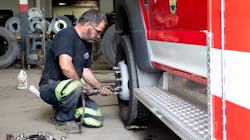What are your risks when it comes to worker injury? Across many tire dealerships throughout the United States, the risks are very high every single day.
Our largest employee demographic is males between the ages of 18 and 40. You know this person. I call him Superman. He’s able to leap down off the alignment rack — without a step stool — in a single bound. He can carry four truck tires on his shoulders instead of rolling them. He squints instead of using safety goggles because his eye lids have super strength and speed. It’s not a tech. It’s not an advisor. It’s Superman!
Until one day, he turns an ankle when jumping down or his back locks up while he’s carrying four tires or worst of all, you have to call his wife and let her know her husband is on the way to the emergency room with a serious eye injury.
While we can’t make injuries 100% preventable, we certainly can do a lot more than we do currently to reduce the likelihood of an accident. For starters, let’s look at the four most common injuries that are recorded in independent automotive dealerships:
Burns. According to OSHA, burns are the number one reported injury in an auto service facility. And if you have never thought about it, it’s likely because there are so many ways of getting burned in a shop. There are the timeless incidents of placing an arm on an exhaust pipe, burning a hand on an engine component, setting fire to oneself with an acetylene torch and gas fumes that catch fire while someone is standing in the fumes while lowering a gas tank. These are just a couple of examples. (Make sure at the very least, fire resistant clothing is available and used properly when using a torch.)
Do not allow your technicians to say something along the lines of “Don’t worry. I won’t make a mistake.” You shouldn’t be worried about them making a mistake. It’s the variables the technician doesn’t control that should worry you. Additionally, any time a worker is working with a gas tank or has gas fumes exposed, the entire shop must know about this and conduct themselves in a heightened, safety-minded manner. The shop should also have ample supplies for burns and severe burns in its first aid kit.
Cuts and lacerations. From sharp metal objects on damaged vehicles to box cutters to slipping on a wrench and your arm goes flying into a rusty bolt, cuts and lacerations are frequent. While very hard to prevent, you can at least have the proper materials on hand to clean and deal with small cuts. For larger lacerations, there should be a driver who can take the employee to the ER or urgent care. Never let an injured employee drive themselves to receive care. Oh, and box cutters? I wish I could say, “Get rid of them,” but please get a pair of cut-resistant gloves. And if anyone ever lays a box cutter down without retracting the blade first, that person isn’t responsible enough to use the tool.
Eye injuries. These injuries are often life-altering and nearly 100% preventable. The risk of eye injury comes from sparks (think grinding wheels), chemicals (burning sensation in the eyes from vapors or actual contact with chemicals in the eye) and flying debris. Eye injuries happen in a flash and are normally not the fault of anyone other than the person who is not wearing their safety glasses. I know it’s a pain and the guys don’t want to wear them, but trust me, you don’t want to be the cause of someone’s lifetime blindness because you looked the other way when your employee was doing something dangerous and his glasses were on top of his head — not over his eyes.
Lifting. Turning your back side to side is not a major risk. Lifting something kind of heavy is a moderate risk. Lifting something heavy and turning is a severe risk. Back injuries are the fourth most common injury in shops.
While not all back injuries are preventable, sometimes they just happen. Reasonable prevention and guidelines can go a long way. No lifting of anything over 30 pounds alone. And has anyone taught your employees proper lifting techniques, like lifting with your legs not your back? How about using existing equipment like dollies or hoists to do the work?
Proper focus on a safe work environment is critical to your dealership. Your worker’s comp expense is already ridiculous, from a financial standpoint, and every employee should go home to their loved ones in the exact condition they arrived at your dealership.
About the Author

Dennis McCarron
Dennis McCarron is a partner at Cardinal Brokers Inc., one of the leading brokers in the tire and automotive industry (www.cardinalbrokers.com.) To contact McCarron, email him at [email protected].
